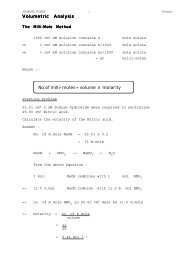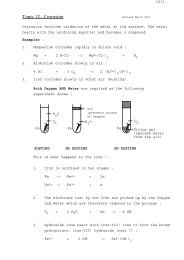Transition Metals - Iandalgleish.co.uk
Transition Metals - Iandalgleish.co.uk
Transition Metals - Iandalgleish.co.uk
Create successful ePaper yourself
Turn your PDF publications into a flip-book with our unique Google optimized e-Paper software.
ADVANCED HIGHER 3 TransMetsIons with charges greater than 4+ are unknown. The energy requiredto pull 4 electrons <strong>co</strong>mpletely off an atom is just too great.Subsequent electrons can however be released from the d orbitalsto form polar <strong>co</strong>valent bonds resulting in many <strong>co</strong>mpounds andions in which Manganese, like all the transition metals, exhibitsa variable valency:e.g. manganate(VII) ion MnO 4-An electrovalent structure for this ion would be impossible. Thehighly positive Mn7+ ion would attract electrons from the O2- ionsresulting in the formation of <strong>co</strong>valent bonds between Mn and O :O 2- O 2-O-O 2-Mn 7+O 2-OMnOOThe electrovalent model is nevertheless useful : we can imaginethe Mn7+ ion protected by a cage of O2- ions. Take away theprotection and you have a highly effective oxidising agent, Mn7+.e.g. Oxidation of chloride by acidified manganate(VII) :MnO 4- + H+ + Cl- -> Mn2+ + H 2 O + Cl 2The oxidation state of Mn decreases from 7 to 2 as it is reducedin this reaction.Manganese exhibits the greatest variety of oxidation states of allthe transition metals :Oxidation state Examples2 Mn2+, MnCl 2- 43 Mn3+4 MnO 2 , MnCl 2- 65 MnO 3- 46 MnO 2- 47 MnO 4-, MnO + 3




